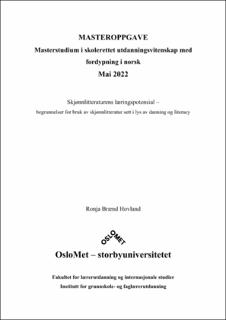| dc.description.abstract | Problemstillingen i denne masteroppgaven er: På hvilken måte kan man forstå læreplanverkets begrunnelser for bruk av skjønnlitteratur i norskfaget i lys av danning og literacy, og hvordan kan disse begrunnelsene kobles til sentrale teorier om litteraturlesingens muligheter? Problemstillingen blir besvart ved bruk av en kritisk diskursanalyse der læreplanverkets begrunnelser for bruk av skjønnlitteratur i norskundervisningen blir analysert og vurdert ut ifra to teorier som kan settes i sammenheng med diskursene danning og literacy. De to teoriene som er benyttet er hentet fra Martha Nussbaum og Lisa Zunshine. Disse er valg ut da teoriene baserer seg på begrunnelser som ikke er så sårbare for endringer i policy som læreplanverket. Målet for oppgaven var å sette søkelys på de begrunnelsene som finnes i læreplanverket, om de er implisitt eller eksplisitt uttrykt, og hvordan disse stiller seg i forhold til skjønnlitteraturens potensial til å bidra i utviklingen av danning og literacy. Utgangspunktet for valget av tema og problemstilling til oppgaven var at tidligere forskning har vist at skjønnlitteraturens læringspotensial i flere tilfeller forblir uutnyttet på bakgrunn av læreplanverkets nyttetenkning og fokus på målbare ferdigheter (Skaftun, Aasen, & Wagner, 2015). Martha Nussbaums filosofi om følelser, der hun forsvarer skjønnlitteraturens rolle i norskfaget, er en av de sentrale teoriene som blir benyttet. Hennes filosofi kobles til danningsbegrepet og brukes for å se sammenhengen mellom skjønnlitteraturens danningspotensial og læreplanverkets overordna mål om danning i opplæringen (Nussbaum, 2016). I tillegg benyttes Lisa Zunshines teori om mind-reading, metarepresentasjon og Theory of Mind for å sette skjønnlitteraturen i sammenheng med utvikling av literacy-kompetanse, som også er en sentral del av læreplanverkets overordna mål (Zunshine, 2006). Funnene i oppgaven tyder på at det finnes en implisitt uttrykt sammenheng mellom læreplanverkets overordna mål for opplæringen og bruken av skjønnlitteratur i norskundervisningen sett i lys av danning og literacy, samtidig blir det tydelig at for å kunne se denne sammenhengen kreves en bevissthet hos leseren. Man er avhengig av en helthetlig læreplanforståelse der alle de ulike delene må sees i sammenheng med hverandre, og der det er avgjørende å ha både innsikt og kunnskap om skjønnlitteraturens læringspotensial, danning og literacy for å forstå læreplanens begrunnelser for bruk av skjønnlitteratur fullt ut.
The research question for this master’s thesis is: “In what way can one understand the curriculum´s justifications for the use of fiction based on formation and literacy, and how can these justifications be linked to central theories about the learning potential of reading fiction?”. The research question is answered using a critical discourse analysis, where the curriculum’s justifications for the use of fiction in the Norwegian school subject are analyzed and assessed based on two theories that can relate to the two discourses formation and literacy. The theories used are taken from Martha Nussbaum and Lisa Zunshine. These are chosen as theories because they are based on justifications that are not as vulnerable to changes in policy as the curriculum. The aim of the thesis was to shed light on the justifications found in the curriculum, whether they are implicitly or explicitly expressed, and how these stands in relation to the fiction´s potential to contribute to the development of formation and literacy. The starting point for the topic and research question of the thesis, was that previous research has shown that the learning potential of fiction in several cases remains untapped based on the curriculum´s utility thinking and measurable skills (Skaftun, Aasen, & Wagner, 2015). Martha Nussbaum´s philosophy of the emotions, in which she defends the role of literary education, are one of the central theories that are used. Her philosophy is linked to the concept of formation and it´s connection between the formation potential of fiction and the curriculum´s overall goal of formation in the education (Nussbaum, 2016). In addition, Lisa Zunshine´s theory of mind-reading, metarepresentational ability and “Theory of Mind” are used to put fiction in the context of the development of literacy competence, which is also a central part of the curriculum´s overall goal for the education (Zunshine, 2006). The findings indicate that there is an implicitly expressed connection between the curriculum´s overall goals of the education and the use of fiction in the Norwegian school subject. At the same time, it becomes clear that to see this connection, an awareness of the reader is required. One is dependent on a holistic understanding of the curriculum where all the different parts must be seen in connection with each other, and where it is crucial to have both insight and knowledge about the learning potential in fiction, formation and literacy, to fully understand the curriculum´s direction for the use of fiction. | en_US |
